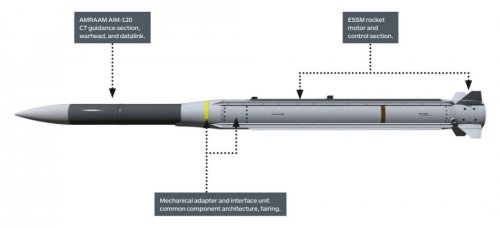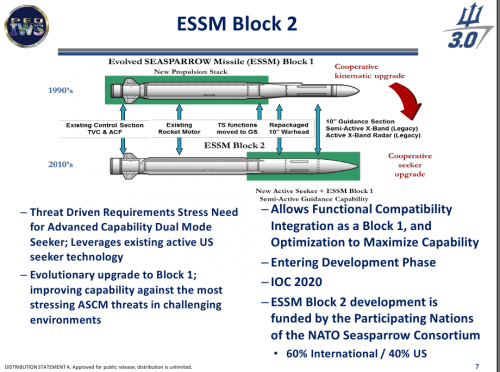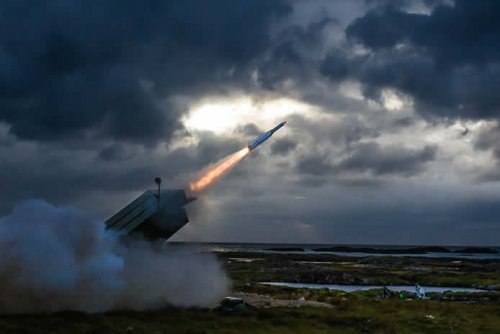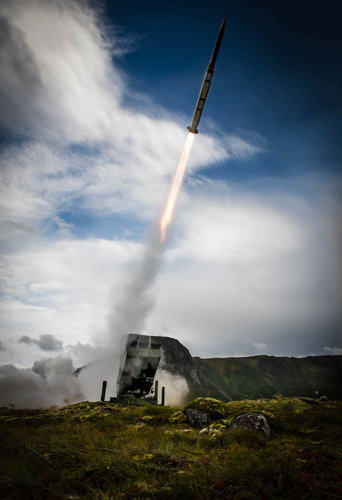AMRAAM ER destroys drone target in first modified Raytheon missile test
An extended range (ER) version of Raytheon's Advanced Medium-Range Air-to-Air Missile (AMRAAM ER) destroyed a target drone in the new missile's first flight test, validating the weapon's compatibility with Kongsberg's National Advanced Surface to Air Missile System (NASAMS) launcher.
Raytheon and Kongsberg plan to conduct upward of four more test flights to expand the system's envelope, Michael High, AMRAAM ER programme manager for Raytheon said recently.
In the 31 August demonstration, an AMRAAM ER, shot from a canister launcher, destroyed a Meggitt Aerial Targets' Banshee 80 target drone. The test occurred at the Andøya Test Center, Andøya Island in northern Norway.
AMRAAM ER, like the legacy AMRAAM, is an all-weather missile with an active seeker. The ER variant uses the guidance section of an AIM-120C-7 and back-end from a RIM-162 Evolved SeaSparrow missile (ESSM), which gives the AMRAAM ER "more than a 50% increase in thrust", High noted.
"Higher speed equals greater manoeuvrability, which gives us capability against a wider range of targets and gives us higher probability of kill once we reach the target," he said.
Both AMRAAM and the ER version can receive updates through an in-flight uplink even though it is an active missile, High noted.
"It continues to receive updates until the seeker goes active," he said.
AMRAAM ER increases the altitude and the range of the legacy missile.
"We know there is a need out there for a medium-range air defence system with proven capability of AMRAAM," High added.
Raytheon also provides the missile interface unit for NASAMS.
NASAMS is a short- to medium-range air defence system, then when combined with AMRAAM, can be used against cruise missiles, hovering targets, fighter aircraft, and unmanned aerial systems, High said.
The NASAMS fire unit includes a Flight Distribution Center (FDC), Sentinel X-band radar that is linked by field wire or radio to the FDC, and the launchers. The FDC is manned by two operators.
For the past 13 years, NASAMS has been providing air defence for the US National Capital Region (NCR), which includes Washington, DC.
"You can have a mixed load out [of AMRAAM and AMRAAM ERs] in NASAMS, so if a country wishes to go [short- or medium-range air defence) from the same system they can do that," High said.
AMRAAM ER is 30.48 cm longer than an AMRAAM. The ER variant is 396.2 cm long, 17.7 cm diameter, and weighs 278.9 kg. AMRAAM is 368.3 cm long, 17.7 cm diameter, and weighs 158.7 kg.
The addition of the ESSM rocket adds 25.4 cm to the ER version's length. The back-end is mated to the AMRAAM missile using an adapter ring, High said.
A single circuit card assembly translates commands from AMRAAM and sends them back to the ESSM fins which control the missile, he added.
"It is relatively low cost and relatively low risk," High said.
Some minor software changes have to be made to the NASAMS' FDC to enable the operators to determine the appropriate range to shoot each missile, when a launcher is loaded with both AMRAAMs and AMRAAM ERs, he said. "That is one change to the FDC."
Minor structural and mechanical changes were also made to the NASAMS canister launcher, High added.
No changes were made to the AN/MPQ-64F1 Sentinel radar, which is the fire-control system for NASAMS.
High added he expects AMRAAM ER to be available in the 2020 timeframe. Raytheon must go through the procedures to make AMRAAM ER available for foreign military sales and the company must be able to fit the ER version into the AMRAAM's production schedule.
COMMENT
Although no decision has been made if the NASAMS units deployed around the NCR will be upgraded to launch AMRAAM ER, Raytheon has offered to conduct live fire demonstrations of the upgraded missile. US Northern Command provides for the support and defence of the NCR.








